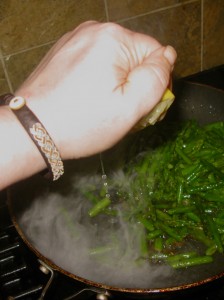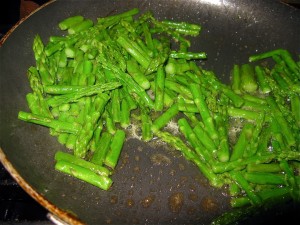Asparagus with Ghee, Cumin and Mustard
This should have been posted on Monday for Meatless Monday, but I forgot and posted about making tender kofta instead. Oh, well–call me a bad blogger this week and look for Meatless Monday coverage again next week.
This dish is so simple and good that I decided not to wait until next week to post it, but to give it to you today. See, now I’m not a bad blogger, but a good one. It all works to everyone’s advantage in the end.
Anyway, this is a great, simple Indian style recipe that shows off asparagus, that paragon of seasonal spring vegetables, at its very best. The native flavor and texture of the asparagus is enhanced by the addition of five ingredients: ghee, mustard seed, cumin seed, lemon juice and salt, and the cooking technique is basic.
It can be varied and livened up, of course. Curry leaves, chili flakes or whole chilies can be added to give the asparagus further zest and flair, but really, I think it’s best to keep it simple, and let the natural flavors of the vegetable shine without competition.
Oh, and one more thing–you can substitute butter for the ghee if you have to, but I urge you to try the ghee first. Its nutty, rich buttery flavor and aroma are part of what makes this dish special. Plain butter just lacks that character.
And yes, if ghee and butter scare you, I guess you can substitute a vegetable oil for them–if you must. However, if you use margarine instead, please don’t tell me about it. I just don’t want to know. It might be good, but it won’t taste like the way I intended it. (And besides–margarine really isn’t any healthier for you than butter–remember artificially hydrogenated vegetable oils contain trans-fats and are not good for you–so if ghee and butter are to be avoided, then use a natural, liquid vegetable oil instead, like peanut, sesame or canola.)
Asparagus with Ghee, Cumin and Mustard
Ingredients:
1 pound thin asparagus spears, bottoms trimmed off and cut into 1 1/2″ pieces
water as needed
1 tablespoon ghee or butter (you can use as little as half a tablespoon, but a tablespoon tastes better)
1/4 teaspoon whole brown mustard seeds
1/4 teaspoon whole cumin seeds
juice of 1/2 lemon (about a tablespoon and a half)
salt to taste
Method:
Put asparagus into a saute pan where the pieces can sit in a single layer on the bottom with little to no overlap. Add water to barely cover the bottom of the pan and come up no more than 1/2 way up the asparagus pieces. DO NOT cover the asparagus with water.
Over high heat, bring the asparagus to a rapid boil and allow the water to begin to boil away. Just as the water is reduced by half, clap a lid on top of the pan and allow the asparagus to steam as the rest of the water boils off.
As soon as the water is gone, remove the lid and add the ghee. Cook, tossing the asparagus, for a minute, then sprinkle with the mustard and cumin seeds and toss to combine. Clap the lid back on the pan and cook, shaking the pan continually, until the mustard seeds sizzle and pop and the cumin seeds brown and become fragrant. This should take no more than a couple of minutes.
Remove the pan from the heat, uncover it and check the asparagus.
At this point the asparagus should be bright green tinged with some brown spots where the sugars have begun to caramelized on the surface of the vegetable. The asparagus should also be slightly wrinkly in appearance and fully tender. If it is not done, sprinkle a little tiny bit of water (like two tablespoons or so) into the pan, put it back on the fire, clap the lid back on and let it steam briefly.
When the asparagus is done to your liking, put the pan back on the fire, and keeping it uncovered, squeeze the juice of one half of a nice sized lemon into the pan. Let the juice mostly boil off before pouring out of the pan into a warmed serving dish.
Sprinkle with salt to taste and toss before serving.
4 Comments
RSS feed for comments on this post.
Sorry, the comment form is closed at this time.
Powered by WordPress. Graphics by Zak Kramer.
Design update by Daniel Trout.
Entries and comments feeds.





You know, I have you to thank for finally starting to cook with ghee! It’s amazing how much flavor it imparts to a dish. I’d always avoided it in favor of canola oil, but man, there’s no going back now!
Comment by Laura B. — April 21, 2011 #
I still use canola sometimes, or mustard oil, if the flavor is proper for the dish, but real ghee is the way to go for full flavor. Especially when making tarka to go into dal or tempering spices to be stirred into a poriyal. The fragrance and flavor are incomparable.
Comment by Barbara — April 21, 2011 #
What a lovely recipe!
This is your (lovely) blog, of course, so the choice of recipes is yours, but I wish we could have more meatless recipes!
Comment by Hadar — April 22, 2011 #
Hadar–I don’t know if you have looked at the archives, but there is a category called Recipes: Almost Vegetarian, Vegetarian, and Vegan. “Almost Vegetarian refers to recipes where a meat ingredients is there for flavor and thus can be removed (Ma Po Tofu) or one which could be adapted for a vegetarian version by replacing the meat with tofu or root vegetables or mixed vegetables.
You are right–we do eat vegetarian at home reasonably frequently, especially considering I am cooking for a four year old and a one-time non-vegetable eater (Zak), but unfortunately, they are not as big of vegetable fans as I am.
This summer, however, do expect to see more vegetable based recipes BECAUSE we are growing so many of them in our garden plot that we will NEED to eat them. (Mommy is sneaky in that she recognizes that children are more apt to eat vegetables they grew themselves.)
Comment by Barbara — April 22, 2011 #